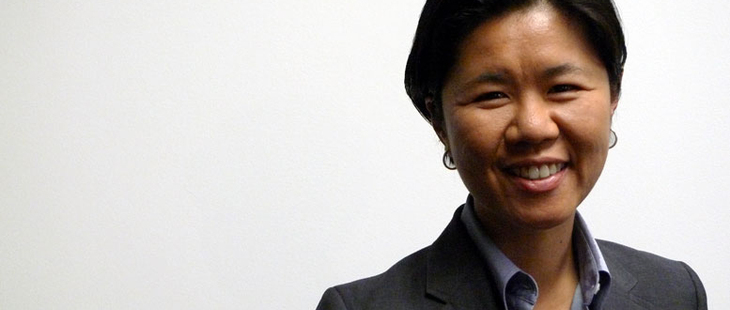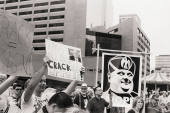

The recent debate to remove the Jarvis bike lanes was as heated as anything the new city council has had to argue over so far and Kristyn Wong-Tam was at the centre of it. As representative for Toronto Centre-Rosedale, the ward that includes the lanes, Wong-Tam was aggrieved she wasn’t consulted about the proposal, or warned that it was even forthcoming. On the floor of council she described the entire process as “dishonest,” earning her a rebuke from Denzil Minnan-Wong, the mayor’s lead on the proposed bike plan.
To further aggravate things, Minnan-Wong amended one of Wong-Tam’s motions in the final moments of the debate to ensure that the fifth, reversible rush hour lane would be returned to Jarvis.
Wong-Tam ultimately lost the day, of course, but her impassioned defence propelled her to the forefront of the current rookie-heavy class of councillors. She insists, however, the fight wasn’t really about bike lanes; she wasn’t even talking about cycling infrastructure. For her, the Jarvis bike lanes were part of a larger vision for a revitalized downtown eastside.
Before the bike lanes even went to committee, Wong-Tam was pursuing projects to turn Jarvis into a cultural corridor. She had begun consulting with local businesses and residents in the burgeoning neighbourhood in order to address its chronic problems.
“What we have right now is somewhat of a troubled neighbourhood, because we’ve got over 1,000 shelter beds wedged into a very small piece of geography cut off from the rest of the city by a five-lane road,” she says. “What we were trying to do locally was diversify the population, remove the five-lane highway and bring a sense of art and culture to actually transform the area.”
When she was elected, it was unclear where she’d fit on a council that seemed to be dividing into camps. She supported Mayor Ford’s moves to get rid of both the vehicle registration and land transfer tax, but she also had a career in social activism. Since then, the newcomer has taken on a steady stream of high-profile issues. The bike lanes are only the latest, along with a fire that destroyed a heritage property in her ward and a plan to revitalize the downtown Yonge St. strip. She likes to think of herself as a “process queen” and has tried to involve people from outside city hall in city planning. She’s fond of words like “collaboration” and “consensus,” but she’s also butted heads with the mayor over Jarvis and his absence from Pride.
Before the Hong Kong-born Wong-Tam joined council, she was an entrepreneur. She worked in real estate at Coldwell Banker, was a Timothy’s World Coffee franchisee, and still owns the eponymous KWT Contemporary art gallery. She’s also a long-time community organizer, both as a founder of the Church-Wellesley BIA and an activist in the LGBT and Chinese-Canadian communities.
In the October election, Wong-Tam emerged from a crowded field of candidates to beat Ken Chan, the candidate endorsed by both George Smitherman and Kyle Rae, the long-serving councillor for Ward 27 Toronto Centre-Rosedale who had chosen to retire. The margin between her and Chan was a slim 462 votes.
+
When I dropped by the councillor’s office last Monday morning, Wong-Tam was meeting with the Lalani family—Noori, Al and his son Al Jr—owners of the site of the Empress Hotel, the heritage property at Yonge and Gould that burned down on January 3, 2011, only a few weeks into the Wong-Tam’s term. It’s evident she still hasn’t completely moved into her new office—the meeting room is lined with paintings and photographs on the floor that haven’t yet been hung up.
Retrieving some notes on his iPad, Al Jr. presents a pitch for the temporary use of the site. He says he’s talked to the Street Food Vendors Association and Barberian’s Steakhouse about transforming it into an open-air food court. And he wants to launch the food court as a pilot project in time for the Scotiabank Caribbean Carnival.
Wong-Tam agrees it’s a good idea and might even provide a foothold for the Asian-style night market she’s envisioned for the future. But before her office can move forward, she says, the Lalanis need to prepare a plan to deal with vendors’ waste. Her executive assistant, Kevin Beaulieu, says that as long as they stick within the current zoning for the site, which used to be the home of the Salad King restaurant, they should be up and running quickly—but the carnival is coming soon, they only have two weeks to put their proposal together.
Before finishing, Wong-Tam encourages the Lalanis to approach the Downtown Yonge Business Improvement Area and local vendors to avoid stepping on anyone’s toes. Al nods in agreement, offering that he intends to “be a good neighbour.”
The idea of neighbourliness has been at the core of Wong-Tam’s planning approach. In drafting a proposal to rebuild Yonge Street after the fire, she reached out to the community, according to James Robinson, executive director of the Downtown Yonge BIA.
“Seeing the citywide significance of the loss of that heritage property, and knowing that there’s tremendous development pressures, she mobilized our community,” Robinson says. “And when I say community I mean it very broadly, not just our business community, but residential and the city itself.”
Wong-Tam’s approach helped her attract some top talent to the file, such as the architect and urban planner Ken Greenberg.
“I continue to be impressed by her ability to bring people together in the community, to work with all parties,” Greenberg says. “We filled all the tables in a hotel ballroom and there were many different interests in the room. She was very good at listening to everyone, at playing back their concerns, at seeking creative compromises and meeting everyone’s needs and expectations. And I think people respect that.”
The next, and possibly most difficult step, will be building support in council for a pilot project to turn a section of Yonge between Dundas and Gerrard into a pedestrian mall.
The truth is, Wong-Tam hasn’t had much success as a legislator. She rarely gets enough support for her amendments. When she proposed a series of amendments to save Jarvis, Minnan-Wong proposed what she called an “unfriendly” amendment to one of her motions. That was the one that ensured the restoration of the fifth, reversible lane.
There was one recent exception. Her amendment calling for stricter enforcement and retroactive billing of corporate graffiti made it into the Mayor Ford’s Graffiti Management Strategy by a vote of 21 to 20. Her amendment calls for corporations to be billed retroactively for using spray paint on sidewalks in so-called guerrilla marketing campaigns.
Wong-Tam worries that council politics will kill the Yonge plan.
“I now have in-principle support from the relevant staff departments—transportation, planning, urban design, public realm staff, office of the environment—I’ve got them all,” she said. “Whether or not that will be overturned on the floor of council as a matter of ideology, that’s a different thing entirely.”
“You’ve got some folks in power that might not want to see community projects succeed, because it doesn’t serve a political agenda. In this case, that political agenda is how do we sell off as much as we can? How do we monetize it? How do we privatize it? How do we outsource it?”
Since Wong-Tam was elected, her office has been humming. She says time has sped up since she turned 40 earlier this year, but between the fire in her neighbourhood and the heated debates at council, who would have time to hang up the office artwork?
Beaulieu, her executive assistant and a City Hall veteran, has been critical in getting the office up to speed. Until the last election, he was former TTC Chair Adam Giambrone’s executive assistant. After Beaulieu failed in his bid to replace Giambrone as the councillor for Ward 18 Davenport, Wong-Tam says he became the “number one draft pick” for new councillors needing staff. While they hadn’t met before the election, Beaulieu says he liked Wong-Tam’s style.
“Kristyn is full of energy, she does not stop working and she’s very good with people, level-headed, reasonable and fair,” he says. When asked, he isn’t interested in making a comparison between his new boss and his old boss.
Beaulieu brought his knowledge of the inner-workings of City Hall and the TTC to the rookie’s office. While Wong-Tam had years of experience as a community organizer, she was unfamiliar with the difficult machinery of city hall. “Kevin actually says: ‘Slow down, Kristyn. You can’t rush off too quickly because you have to bring people in.’”
Beaulieu helped Wong-Tam stickhandle the ambitious Yonge Street Revitalization Plan. He flagged the key junctures when city staff needed to be brought onboard and his TTC knowledge helped with the proposal for a new entrance to the Dundas subway station on Gould.
City hall also demands councillors adjust to the political climate. She said the Jarvis debate reminded Wong-Tam of something her Buddhist advisor, Grace, told her before she ran for office: “Politics is dirty if you think politics is dirty.”
Wong-Tam waits a beat then laughs. She admits it sounds a little “new agey” and “circular,” but she isn’t being ironic. “If we removed our ego from the debates that are so heated and steeped in ideology and dogma, and we actually listen to the merits of the points that are being made, I think we would treat each other with far more respect than is being demonstrated on the floor of council. And we’d be able to move the city faster and more forward, together as a cohesive council.”
+
Putting ego aside is one thing, but it doesn’t mean Wong-Tam isn’t confident about who she is and what she believes. She stands by her convictions and also acknowledges that who she is gives her certain responsibilities. She is the first openly lesbian Toronto councillor and presently the only one who is ‘out’—a fact that put her at odds with Mayor Ford when he decided not to march in the Pride Parade or attending any of its events.
“During the events surrounding Pride, I believe that my community needed me to speak up,” she says. “I don’t want to be the one that [has to] speak on every LGBT issue, but I know it’s expected of me.”
Beaulieu says that instead of scolding the mayor, Wong-Tam wanted to help Ford reach out to the LGBT community. “Kristyn never really went on the attack,” he says. “It was really important for her that the mayor be the mayor for the LGBT community as well.”
Wong-Tam says she was talking to the mayor’s staff in the months prior to the Pride celebrations in order to find a situation in which the mayor would be comfortable making an appearance.
“I don’t want to be too harsh about the mayor not coming out to Pride,” she says. “I honestly believe that he’s uncomfortable around gay people. I honestly believe that based on conversations that he and I have had, and certainly based on conversations I’ve had with his staff.”
His decision about Pride, however, wasn’t the first time Ford’s rough edges caught Wong-Tam’s attention. In 2008, when Rob Ford was still a gaffe-prone councillor, it was Wong-Tam as private citizen who led a protest against Ford’s infamous remark that “Oriental people work like dogs” and were “slowly taking over.” Wong-Tam organized a “sleep-in” in front of Councillor Ford’s office demanding an apology. Ford eventually did apologize for his comment, though he insisted it was a compliment about the Asian work ethic.
After winning her council seat, Wong-Tam told the Toronto Star that the controversy and sleep-in were part of a “different era.” She’s moved on from the theatrics of political activism and traded it in for the sober responsibility of her office. “I don’t actually miss it because I know I have a new role to play. It’s an incredible privilege to serve and I don’t want to squander it for any reason,” she says.
+
On the day I spent with Wong-Tam, she exchanged hellos with Councillor Mike Del Grande, the mayor’s budget chief, and Deputy Mayor Doug Holyday in the hallway. Wong-Tam says there’s still courtesy and respect among councillors, even if she felt colleagues John Parker and Minnan-Wong didn’t give her fair notice on Jarvis.
The next battle at city hall will come via Del Grande and Holyday, as they work on balancing the city’s budget in light of the KPMG service review. For all the friendliness in the halls, Wong-Tam says if the city commits exclusively to cutting services and implementing fees, it will push Toronto into decline.
“If we turn off the taps of city building, we don’t build innovation. We don’t build growth with respect to development by abandoning social infrastructure and capital infrastructure programs because the tax base which the city is so dependent will automatically shrink,” she says. “Right now there’s no business that’s more nervous than the development industry.”
The past two weeks, the city’s various committees have been considering service cuts on everything from snow clearing to water fluoridation. Since then, KPMG reports have included recommendations to cut AIDS and drug prevention programs, reduce the number of daycare spaces, and shrink the public library system.
Solutions aren’t all going to come from the municipal government, Wong-Tam says, but the private sector doesn’t have the “buckets of money” that some think can be used to solve the city’s problems. That’s why she’s struck out on her own, whether on Jarvis or Yonge, using the city’s offices to broker partnerships. However, she says the city’s political climate is making that difficult.
“The truth doesn’t necessarily matter for some, if it hinders their political expediency,” she says.
While she says her ward has become a lightening rod because it’s the heart of the downtown under a suburban-minded mayor, she refuses to entertain the idea of returning the city to its pre-amalgamation borders.
“Ultimately the responsibility is for downtown to continue to grow so we can continue to create the wealth to help our suburban neighbour. The vertical poverty in the inner suburbs is so dramatic it actually needs downtown Toronto dollars in order for the suburbs to prosper,” she says.
“And it’s our responsibility now to stay in the game so we can pull the city forward together.”














